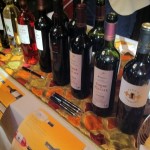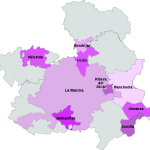Last week, I attended my first wine event as a member of the “trade”. The event was hosted by “Wines of La Mancha“. Since it was my first such event as a member of the trade, I wasn’t sure what to expect, other than Spanish Wine – which I enjoy, having had wines mostly from the La Rioja, Castilla y Leon, Aragon, and Galicia regions. It was a walk-around tasting with 11 wineries represented.
It turned out to be a top shelf event at Robert Fountain Studio in the Potrero Hill neighborhood in San Francisco. In particular, the food served was remarkable, with whole roasted pig being the centerpiece of a bounty that included a wonderful assortment of Spanish tapas-style small plates.
Click images to enlarge
I must confess I knew little about the La Mancha DO. While doing some “discovery”, I noted little (The Concise World Atlas of Wine), or nothing ( The Wine Bible) was said about La Mancha – thus the event; to heighten awareness of this wine region which lives in the shadows of more renown wine regions in Spain like La Rioja, Catalonia (Priorat), Castilla and Leon (Ribero del Duero), and Andalusia, from which Sherry hails.
Here’s the 411 on La Mancha:
- Part of the Castilla-La Mancha autonomous community
- Largest of 9 DOs in Castilla-La Mancha, which is the largest continuous vine-growing area in the world
- Claim to fame – The stomping grounds of the famed literary figure Don Quixote
- Climate – According to a local proverb – “nine months of winter and three months of hell”
- Authorized red grapes: Cencibel (a.k.a Tempranillo, Grenache, Moravia, Cabernet Sauvignon, Merlot and Syrah
- Authorized white grapes: Airén (pronounced “Aye ran”), Macabeo (a.k.a. Viura), Chardonnay, Verdejo, Moscatel de grano menudo, and Sauvignon Blanc
- Achieved DO status in 1976
- Known for producing wines with great price/quality ratio, and formerly known for producing bulk wines
It’s always fun for me to try new grape varietals. I tried Airén, and Macabeo, on a standalone basis, for the first time. And there were some wines I really enjoyed, and/or found interesting.
My favorites whites:
Anil Macabeo – 100% Macabeo. Tropical fruit, herb nose. Tropical, citrus palate. Juicy light-medium mouth feel. Short finish – 87pts
Allozo Verdejo – 100% Verdejo. Grassy, citrus, faint vanilla nose. Stone fruit, citrus palate. Light bodied with crisp acidity, and slightly bitter on back palate. Short finish – 86pts
My favorite reds were:
La Villa Real Reserva – Aromatic nose of black currant, oak, and spice. Black currant, dark cherry, chocolate palate. Med-long finish – 88pts
Casa Antonete Gran Reserva – Black currant, oak, leather nose. Cherry, coffee palate, and smooth tannins. Long finish – 90pts
Casa Antonete Crianza – Intense cherry/black currant liqueur nose. Vibrant cherry palate. Balanced. Medium finish – 89pts
Torre de Gazate Reserva – 50/50;Cencibel/Cab blend. Tobacco, cherry, oak nose. Currant, cherry, spice palate. Medium finish – 87pts
I was also pleasantly surprised at the prices for the higher quality wines. Most of the wines lived up to their great price/quality reputation.
On the other hand, I found the majority the whites I tasted to be a bit austere for my tastes. And quite a few of the reds, too tannic for my tastes (And i like a wine with some grip). I also found that I didn’t care much for the Young wines I tasted. But, I also think the wines may have been served too warm, and I look forward to trying a Young wine again served at a cooler temperature.
The verdict? For me, I enjoyed the wines, though not as much as comparable wines I’ve had from Rioja, Ribero, or Priorat. However, it’s clear to me that La Mancha is a full participant in the Spanish wine revolution that’s bringing modern wine making techniques, experimentation with other than traditional grape varietals, and new plantings/re-plantings to Spain. While it’s “not there yet” La Mancha is on the rise, and on my radar!
Related articles
- The Wines of Spain (winebookclub.org)



Martin,
I am so glad you got to go to this tasting. I had hoped to, but have been stuck in negotiations with our primary union for the past week, including until very late Monday night, so there was just no way I could make it. I appreciate your report. Sounds like a very educational tasting.
–Richard